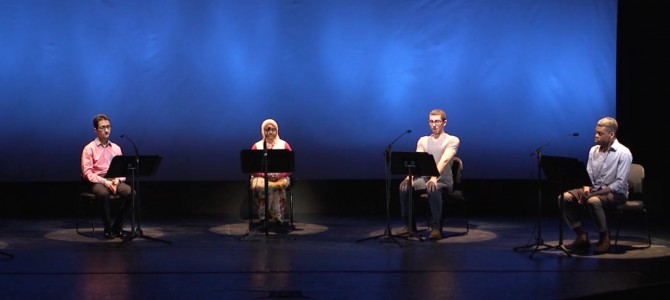A play promoting the benefits of entitlement reform. A sculpture honoring the Second Amendment. An exhibition displaying the history of traditional marriage. None of these projects has received taxpayer funding from the National Endowment for the Arts (NEA), or ever will. But the reverse is true for pet issues of the Left.
Name a liberal political issue—gun control, climate change, open immigration, gender identity—and you can find a government-funded art project that promotes it. Last month the agency doled out thousands of dollars for a play about activist lesbians who “are staunchly opposed to gun ownership.” They paid $20,000 for a series of “climate change-themed public art installations” in Minneapolis. Checking the immigration reform box, it approved a theatrical interpretation of President Obama’s deferred action program for $40,000.
Dear Taxpayers: Thanks for Paying Us to Inform Your Politics
Taxpayers funded a play that centers on Michael Brown, which employs the thoroughly debunked “hands up, don’t shoot” meme.
“It may have set some kind of speed record for turning a news event into a theatrical one,” Peter Marks began his review for the Washington Post in November 2014. “Three months after Ferguson, Mo., became a household name, the city’s unrest over a white police officer’s killing of a black teenager has been incorporated into a play.”
The play, “Collidescope: Adventures in Pre- and Post-Racial America,” put on by the New York City theater group Ping Chong and Company, was not the only theatrical production to receive NEA funding on such a political topic. “We Are Dinosaurs” secured $15,000 to “explore race relations in our country with a focus on the recent deaths of young African-American men in police shootings.”
Ping Chong also received money from the taxpayers for “Beyond Sacred,” which tells the stories of five Muslims living in New York City after 9/11, in a time of “increasing Islamophobia.”
Turnabout Would Be Fairer Play
During the Bush years there were no NEA grants promoting the Iraq War, or plays advocating for No Child Left Behind. The only art project to mention either Iraq or Afghanistan was a $10,000 grant for a photograph and oral history exhibit of female wounded warriors.
Despite a Republican being in the White House, works dedicated to liberal causes managed to get funding, while no projects with a hint of a conservative agenda can be found. In 2007, the Chicago Humanities Festival received $10,000 for writers, musicians, and visual artists to “participate in symposia centered on the issue of global warming.”
The San Francisco International LGBT Film Festival received numerous grants during the Bush administration, and the University of Southern California was given $32,000 for an exhibition entitled, “Mixed Feelings,” an art show about immigration. The exhibit imagined southern California as “post-border,” or having no national boundaries.
“It is not confined to a political line on the map,” the exhibit’s curator Michael Dear said. “It goes across America all its cities and towns. The rule of the day is hybridity, not homogeneity. We’re simply ahead of the curve a prototype of the future.”
The grant for “Mixed Feelings” was awarded in 2002, well before the president’s failed push at comprehensive immigration reform five years later.
Propaganda Isn’t Art, People
So how does this happen? The president appoints the chairman of the NEA, who then chooses field directors who hold two-year appointments. While some appointees may stay for just two years, others remain at the agency for much longer. For instance, Douglas Sonntag, who is the dance director, has been with the NEA since 1997.
Who approves the individual grants is a different story. The first round of this fiscal year’s grants were awarded to 1,126 different individuals and organizations across the country.
The sheer number of grants, and number of panelists who approve them—237 for the latest round—make it likely that political projects slip through the cracks. The projects the panelists choose then go through the National Council of the Arts, the NEA’s advisory body, which makes recommendations for what should get funding. But ultimately, the decision for every single award lies in the hands of the chairman, the NEA says.
The simplest answer is that people in the art world tend to lean to the left on the political spectrum, making them more likely to select projects that align with their worldview. Furthermore, liberals do not tend to see their issues as political: climate change is settled science, “there are not two sides” to the debate over same-sex marriage, etc.
Perhaps past NEA appointees who tended to be more conservative were too afraid to deny grants for promoting a liberal agenda. The solution is for the next Republican chairman to fund the premiere of a traveling musical that preaches to its audience that climate change is a hoax to enrich the likes of Al Gore.
But that’s not art, and liberal taxpayers certainly wouldn’t (and shouldn’t) put up with it. Don’t make conservative taxpayers put up with it, either.









